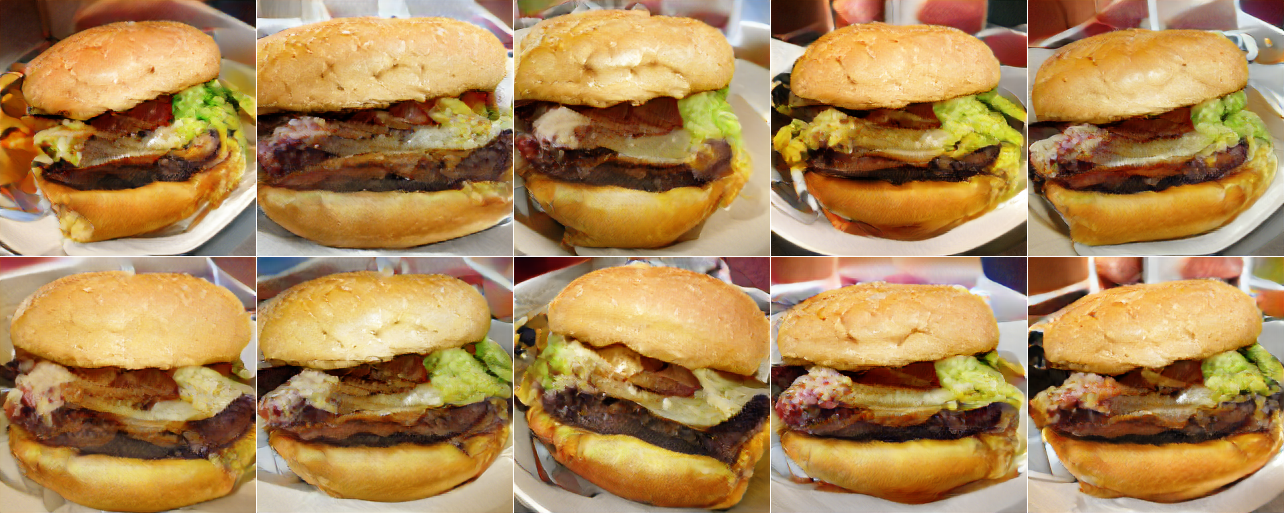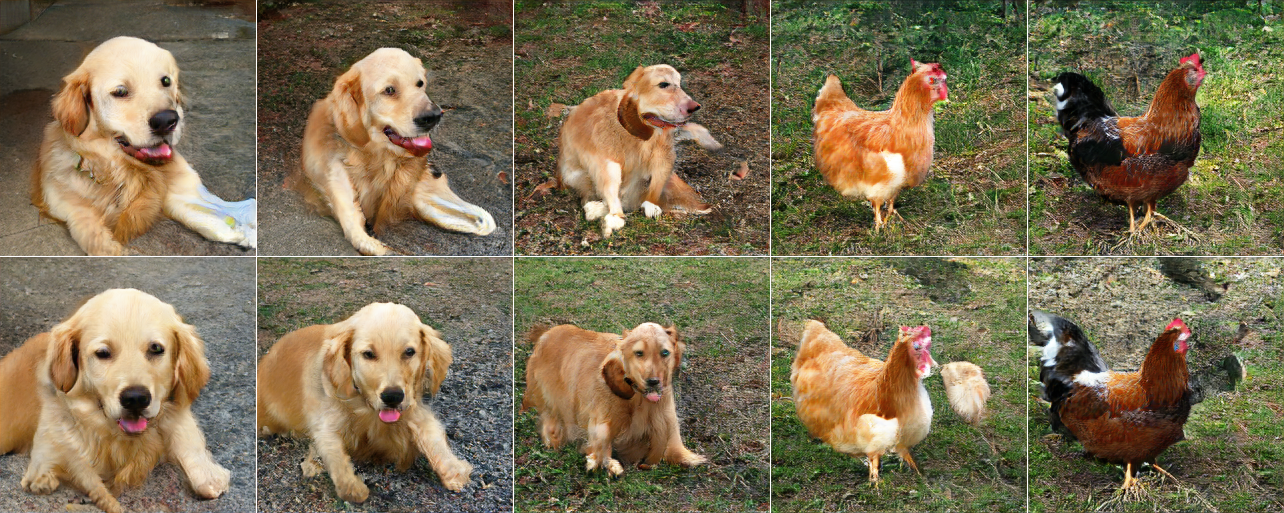 TensorFlow.org で表示 TensorFlow.org で表示
|
 Google Colabで実行 Google Colabで実行
|
 GitHub でソースを表示 GitHub でソースを表示
|
 ノートブックをダウンロード ノートブックをダウンロード |
 TF Hub モデルを参照 TF Hub モデルを参照 |
このノートブックは TF Hub で利用できる BigGAN 画像ジェネレータのデモです。
モデルの詳細については、arXiv の BigGAN に関する論文 [1] をご覧ください。
ランタイムに接続した後、以下の指示に従ってください。
- (オプション)下記の最初のコードセルで選択した
module_pathを更新して、異なる画像解像度用の BigGAN ジェネレータを読み込みます。 - Runtime > Run all をクリックして各セルを順番に実行します。
- その後、スライダーやドロップダウンメニューを使用して設定を変更すると、インタラクティブな視覚化が自動的に更新されます。
- 自動的に更新されない場合は、セルの横にある Play ボタンを押して、手動で出力を再レンダリングします。
注意: 問題が生じる場合は、Runtime > Restart and run all... をクリックすると、ランタイムを再起動して始めからすべてのセルの再実行ができます。
[1] Andrew Brock・Jeff Donahue・Karen Simonyan『Large Scale GAN Training for High Fidelity Natural Image Synthesis』arxiv:1809.11096 (2018)
まず、モジュールのパスを設定します。デフォルトでは <a href="https://tfhub.dev/deepmind/biggan-deep-256/1">https://tfhub.dev/deepmind/biggan-deep-256/1</a> から 256x256 画像用の BigGAN-deep ジェネレータを読み込みます。128x128 や 512x512 の画像の生成や、オリジナルの BigGAN ジェネレータを使用する場合は、アクティブな module_path 設定をコメントアウトして、その他のうち 1 つをアンコメントします。
# BigGAN-deep models
# module_path = 'https://tfhub.dev/deepmind/biggan-deep-128/1' # 128x128 BigGAN-deep
module_path = 'https://tfhub.dev/deepmind/biggan-deep-256/1' # 256x256 BigGAN-deep
# module_path = 'https://tfhub.dev/deepmind/biggan-deep-512/1' # 512x512 BigGAN-deep
# BigGAN (original) models
# module_path = 'https://tfhub.dev/deepmind/biggan-128/2' # 128x128 BigGAN
# module_path = 'https://tfhub.dev/deepmind/biggan-256/2' # 256x256 BigGAN
# module_path = 'https://tfhub.dev/deepmind/biggan-512/2' # 512x512 BigGAN
セットアップ
import tensorflow.compat.v1 as tf
tf.disable_v2_behavior()
import os
import io
import IPython.display
import numpy as np
import PIL.Image
from scipy.stats import truncnorm
import tensorflow_hub as hub
2024-01-11 18:23:02.880491: E external/local_xla/xla/stream_executor/cuda/cuda_dnn.cc:9261] Unable to register cuDNN factory: Attempting to register factory for plugin cuDNN when one has already been registered 2024-01-11 18:23:02.880545: E external/local_xla/xla/stream_executor/cuda/cuda_fft.cc:607] Unable to register cuFFT factory: Attempting to register factory for plugin cuFFT when one has already been registered 2024-01-11 18:23:02.882043: E external/local_xla/xla/stream_executor/cuda/cuda_blas.cc:1515] Unable to register cuBLAS factory: Attempting to register factory for plugin cuBLAS when one has already been registered WARNING:tensorflow:From /tmpfs/src/tf_docs_env/lib/python3.9/site-packages/tensorflow/python/compat/v2_compat.py:108: disable_resource_variables (from tensorflow.python.ops.variable_scope) is deprecated and will be removed in a future version. Instructions for updating: non-resource variables are not supported in the long term
TF Hub から BigGAN ジェネレータモジュールを読み込む
tf.reset_default_graph()
print('Loading BigGAN module from:', module_path)
module = hub.Module(module_path)
inputs = {k: tf.placeholder(v.dtype, v.get_shape().as_list(), k)
for k, v in module.get_input_info_dict().items()}
output = module(inputs)
print()
print('Inputs:\n', '\n'.join(
' {}: {}'.format(*kv) for kv in inputs.items()))
print()
print('Output:', output)
Loading BigGAN module from: https://tfhub.dev/deepmind/biggan-deep-256/1
INFO:tensorflow:Saver not created because there are no variables in the graph to restore
INFO:tensorflow:Saver not created because there are no variables in the graph to restore
Inputs:
z: Tensor("z:0", shape=(?, 128), dtype=float32)
y: Tensor("y:0", shape=(?, 1000), dtype=float32)
truncation: Tensor("truncation:0", shape=(), dtype=float32)
Output: Tensor("module_apply_default/G_trunc_output:0", shape=(?, 256, 256, 3), dtype=float32)
サンプリングの関数を定義して BigGAN 画像を表示する
input_z = inputs['z']
input_y = inputs['y']
input_trunc = inputs['truncation']
dim_z = input_z.shape.as_list()[1]
vocab_size = input_y.shape.as_list()[1]
def truncated_z_sample(batch_size, truncation=1., seed=None):
state = None if seed is None else np.random.RandomState(seed)
values = truncnorm.rvs(-2, 2, size=(batch_size, dim_z), random_state=state)
return truncation * values
def one_hot(index, vocab_size=vocab_size):
index = np.asarray(index)
if len(index.shape) == 0:
index = np.asarray([index])
assert len(index.shape) == 1
num = index.shape[0]
output = np.zeros((num, vocab_size), dtype=np.float32)
output[np.arange(num), index] = 1
return output
def one_hot_if_needed(label, vocab_size=vocab_size):
label = np.asarray(label)
if len(label.shape) <= 1:
label = one_hot(label, vocab_size)
assert len(label.shape) == 2
return label
def sample(sess, noise, label, truncation=1., batch_size=8,
vocab_size=vocab_size):
noise = np.asarray(noise)
label = np.asarray(label)
num = noise.shape[0]
if len(label.shape) == 0:
label = np.asarray([label] * num)
if label.shape[0] != num:
raise ValueError('Got # noise samples ({}) != # label samples ({})'
.format(noise.shape[0], label.shape[0]))
label = one_hot_if_needed(label, vocab_size)
ims = []
for batch_start in range(0, num, batch_size):
s = slice(batch_start, min(num, batch_start + batch_size))
feed_dict = {input_z: noise[s], input_y: label[s], input_trunc: truncation}
ims.append(sess.run(output, feed_dict=feed_dict))
ims = np.concatenate(ims, axis=0)
assert ims.shape[0] == num
ims = np.clip(((ims + 1) / 2.0) * 256, 0, 255)
ims = np.uint8(ims)
return ims
def interpolate(A, B, num_interps):
if A.shape != B.shape:
raise ValueError('A and B must have the same shape to interpolate.')
alphas = np.linspace(0, 1, num_interps)
return np.array([(1-a)*A + a*B for a in alphas])
def imgrid(imarray, cols=5, pad=1):
if imarray.dtype != np.uint8:
raise ValueError('imgrid input imarray must be uint8')
pad = int(pad)
assert pad >= 0
cols = int(cols)
assert cols >= 1
N, H, W, C = imarray.shape
rows = N // cols + int(N % cols != 0)
batch_pad = rows * cols - N
assert batch_pad >= 0
post_pad = [batch_pad, pad, pad, 0]
pad_arg = [[0, p] for p in post_pad]
imarray = np.pad(imarray, pad_arg, 'constant', constant_values=255)
H += pad
W += pad
grid = (imarray
.reshape(rows, cols, H, W, C)
.transpose(0, 2, 1, 3, 4)
.reshape(rows*H, cols*W, C))
if pad:
grid = grid[:-pad, :-pad]
return grid
def imshow(a, format='png', jpeg_fallback=True):
a = np.asarray(a, dtype=np.uint8)
data = io.BytesIO()
PIL.Image.fromarray(a).save(data, format)
im_data = data.getvalue()
try:
disp = IPython.display.display(IPython.display.Image(im_data))
except IOError:
if jpeg_fallback and format != 'jpeg':
print(('Warning: image was too large to display in format "{}"; '
'trying jpeg instead.').format(format))
return imshow(a, format='jpeg')
else:
raise
return disp
TensorFlow のセッションを作成して変数を初期化する
initializer = tf.global_variables_initializer()
sess = tf.Session()
sess.run(initializer)
特定のカテゴリの BigGAN サンプルを探索する
truncation 値を変更してみてください。
(セルをダブルクリックするとコードが表示されます。)
Category-conditional sampling
num_samples = 10
truncation = 0.4
noise_seed = 0
category = "933) cheeseburger"
z = truncated_z_sample(num_samples, truncation, noise_seed)
y = int(category.split(')')[0])
ims = sample(sess, z, y, truncation=truncation)
imshow(imgrid(ims, cols=min(num_samples, 5)))

BigGAN サンプル間を補間する
異なる category に同じ noise_seed を設定したり、同じ category に異なる noise_seed を設定したりしてみてください。または、両方を好きなように設定することも可能です!
(Double-click on the cell to view code.)
Interpolation
num_samples = 2
num_interps = 5
truncation = 0.2
noise_seed_A = 0
category_A = "207) golden retriever"
noise_seed_B = 0
category_B = "8) hen"
def interpolate_and_shape(A, B, num_interps):
interps = interpolate(A, B, num_interps)
return (interps.transpose(1, 0, *range(2, len(interps.shape)))
.reshape(num_samples * num_interps, *interps.shape[2:]))
z_A, z_B = [truncated_z_sample(num_samples, truncation, noise_seed)
for noise_seed in [noise_seed_A, noise_seed_B]]
y_A, y_B = [one_hot([int(category.split(')')[0])] * num_samples)
for category in [category_A, category_B]]
z_interp = interpolate_and_shape(z_A, z_B, num_interps)
y_interp = interpolate_and_shape(y_A, y_B, num_interps)
ims = sample(sess, z_interp, y_interp, truncation=truncation)
imshow(imgrid(ims, cols=num_interps))

